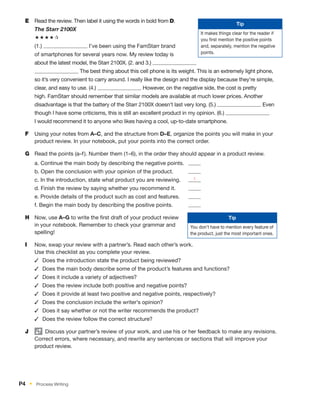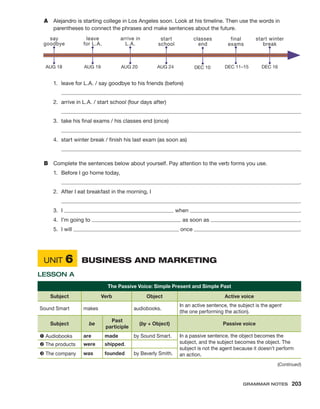Here are the key learning outcomes I saw demonstrated in this conversation:
- I can disagree politely by saying things like "I agree up to a point" or "I see what you're saying, but..."
- I can talk about actions/facts in the past using the simple present perfect with adverbs like still, yet, already, just, and never.
- I can express different meanings using phrasal verbs like turn on, run into, and ask out.
- I can listen for specific information and details.
- I can read passages for detailed information and make inferences.
- I can talk about rules and customs using structures like "It's normal for us to..." and "E
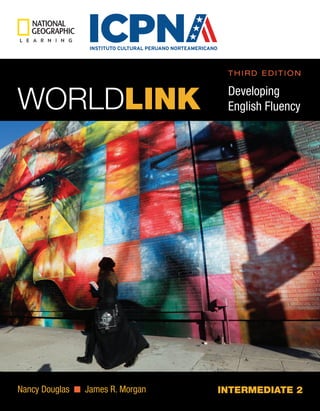















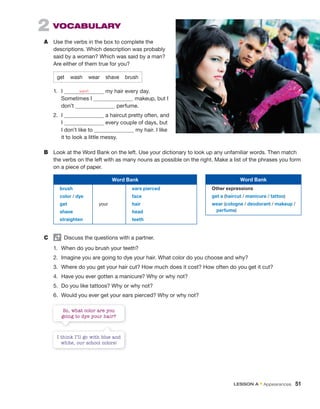




























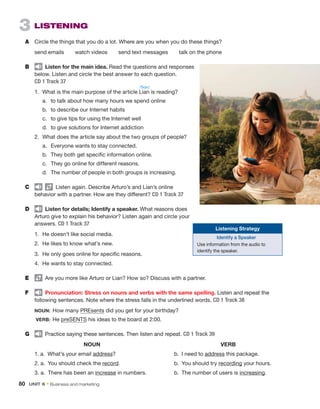













![2 QUEstion FormULation
A In your notebook, make questions with the words in the box. Use either the simple present or the
present perfect.
dye / hair get / tattoo pierce / nose shave / head wash / hair wear / make-up
1. [Yes / No]
2. [Yes / No]
3. When
4. Where
5. [Yes / No]
6. When
B Work with a partner. Ask and answer questions. Give answers that are true for you.
1. Have you ever shaved your head?
2. Do you think getting a tattoo is a good idea?
3. Have you ever broken up with someone?
4. When have you worn make-up?
5. What do you think about piercing your eyebrow?
6. Have you ever run into a famous actor?
1 aCCUraCY PraCtiCE
A Complete the email using the adverbs in the box.
Hi Celia,
already ever just never still yet
Here’s how the party planning is going… I’ve (1.) already chosen the venue, but I
(2.) haven’t sent out the invitations. I’ve (3.) finished
making the guest list, though. I’m glad that’s done! And I need to decide on the menu. I haven’t done
that (4.) . I’ve (5.) planned such a big party before!
How about you? Have you (6.) organized something this complicated?
Talk to you soon—Ken
4 Writing
A Write a paragraph (10 sentences) about dating. Be sure to answer these questions:
• What do you think about dating? Why? • [if yes] How did you meet him or her?
• Do you have a boyfriend or girlfriend? • [if no] How would you like to meet someone?
3 sPEaKing
A Share a love story you have heard about with your
partner. Use the phrasal verbs in the box. Your partner will
listen to you and ask questions. Switch roles and decide
which story is more interesting. Then share your stories with the class.
I’ll tell you how my
parents met.
No! He actually asked
her best friend out...
Did your father ask
your mother out?
Have you washed your hair yet?
ask out cheat on get over grow up
break up get along go out run into
C8 Unit 4 • Unit Consolidation
Unit 4 CONSOLIDATION
International Exam Preparation and Communication Practice](https://image.slidesharecdn.com/intermediatetwobook-210504202447/85/Libro-Intermedio-2-60-320.jpg)

![2 QUESTION FORMULATION
A In your notebook, make questions with the words in the box and the verb to be.
all right / ask / knife and fork appropriate / eat / fingers correct / leave / tip
OK / wear / shoes inside necessary / speak / English perfectly normal / eat / chopsticks
1. Where
2. [Yes / No]
3. When
4. [Yes / No]
5. Where
6. [Yes / No]
B Work with a partner. Ask and answer questions. Give answers that are true for you.
1. Is it ever correct to eat with your fingers?
2. When is it appropriate to kiss someone on
the cheek?
3. How is it possible to feel less homesick
when you’re away from home?
4. Is it all right to answer your phone in a
crowded elevator?
5. Where is it OK to put your bag on the seat
next to you?
6. Before you go to a new country, is it a
good idea to learn the language?
1 ACCURACY PRACTICE
A Complete the sentences using the time expressions in the box. You will need to use some words
more than once.
after as soon as before once when
1. Once you get to know
your host family better, you’ll feel happier.
2. In France, you kiss people on both cheeks
you meet them.
3. Don’t start eating
your host does.
4. dinner, offer to help
wash the dishes.
5. It’s rude to talk you
have food in your mouth.
6. you go into the
mosque, take off your shoes.
3 SPEAKING
A Create a timeline with your future plans. Include important events like graduating, getting a job,
and having a family. Use time clauses with before, after, when, as soon as, and once to explain your
timeline to your partner.
Now In 5
years
Finish college
In 15
years
In 20
years
In 10
years
B group
Share your plans with the class.
As soon as I finish college,
I will look for a job.
And when you get one, will
you buy a new car?
Where is it OK to wear shoes inside?
C10 UNIT 5 • Unit Consolidation
UNIT 5 CONSOLIDATION
International Exam Preparation and Communication Practice](https://image.slidesharecdn.com/intermediatetwobook-210504202447/85/Libro-Intermedio-2-62-320.jpg)





